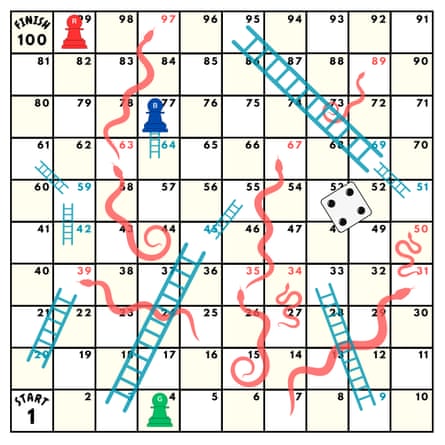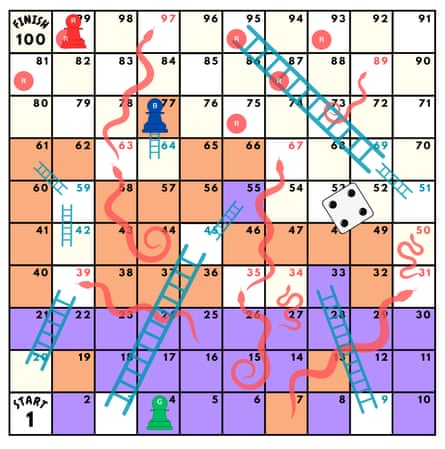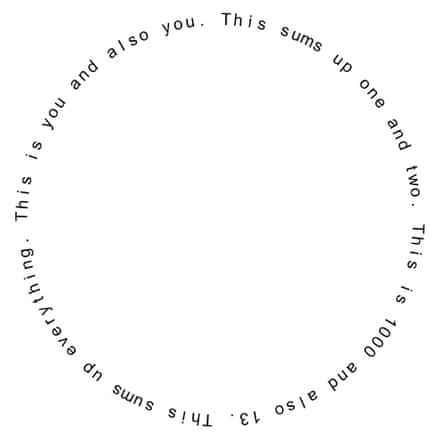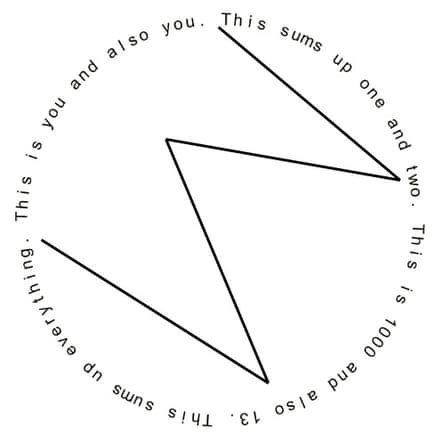Earlier today I set you the following two puzzles. The first is a retrograde analysis puzzle about snakes and ladders, and in the second you have to work out a symbol. Here they are again with solutions.
1. Brand new it’s retro
Three young children, Red, Green, and Blue are playing snakes and ladders. They are called away, leaving the board, including the die, as below. The die is showing the last number rolled.
Deduce whose turn it now is, and the order of play.

Some clarifications about the rules of snakes and ladders that the kids are playing.
-
The game starts with each player putting their marker on 1.
-
Each player roles a single die. If you roll a 6, you get an extra throw.
-
The players take turns in a fixed order.
-
You go up ladders, and down snakes. It is possible to go up two ladders, or down two snakes, or up a ladder and down a snake on the same turn.
-
The winner is the player who lands exactly on 100. (If you are on 98 and roll a 3, you ‘bounce back’ and land on 99.)
-
If a player lands on a square occupied by another player, the player is not sent back to square 1.
I’ll give you one hint: the game that was played was rather extreme – a lot of 6s were rolled!
Solution It’s Green’s turn, and after that it’s time for the fourth round, with Red playing next.
Workings
1. Green has had either one or two turns. This is because Green started on 1 and is now on 4. Green cannot have landed on 3, since this is the bottom of a ladder, and thus Green has had either one turn (throwing a 3), or two turns (throwing a 1 and a 2).
2. Red and Blue have had either two or three turns. This is because if Green has had at most two turns, then the others must have had at most three turns. You also need to eliminate the chance that Red and Blue have had a single turn: you cannot get to where Red and Blue are in a single turn. If you throw 6s ad infinitum, for example, you cannot progress further than position 31.
3. Red has had three turns. This is because you cannot get to square 99 in two turns. In the following grid, all the purple squares are the possible positions after one roll of the dice and all the orange squares are the possible positions after two rolls of the dice.

4. Red did not play last. Thus Blue played last. This is because it is impossible to reach square 99 having thrown a 4 as the last throw in the third turn. The squares with a R in a red circle are the only squares that will reach square 99, with a 4 the final throw. (i.e a 4, or a 6 then a 4, or two 6s and then a 4, and so on.)
We can conclude that the order is Red, Blue, Green. Red and Blue have thrown three times, so Green is next and after that Red begins the fourth round.
2. The missing symbol
What symbol would fit perfectly in the centre of this logo?

Each of the statements describes the symbol neatly. (One of the statements requires knowledge of mathematical notation, but the other three don’t.)
Solution

Key: the symbol is either a W, an M, a 3, or a ∑ depending on how you position it.
This is you and also you: ‘double you’, or W
This sums up one and two: 3
This is 1000 and also 13: M, which is Roman numerals for 1000, and the 13th letter of the alphabet.
This sums up everything: ∑, the mathematical notation for ‘the sum of’.
I hope you enjoyed today’s puzzles. I’ll be back in two weeks.
Thanks to Ammar Fathin Sabili, who created both of today’s puzzles.
I set a puzzle here every two weeks on a Monday. I’m always on the look-out for great puzzles. If you would like to suggest one, email me.
I give school talks about maths and puzzles (online and in person). If your school is interested please get in touch.











